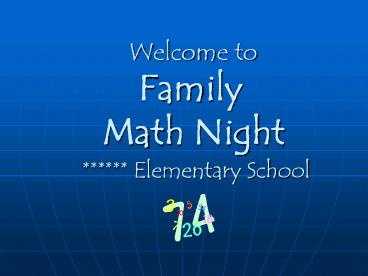Welcome to Family Math Night ****** Elementary School - PowerPoint PPT Presentation
1 / 20
Title:
Welcome to Family Math Night ****** Elementary School
Description:
Welcome to Family Math Night ***** Elementary School Our Core Beliefs We believe that 1. kids come first. 2. continuous improvement is critical for success of the ... – PowerPoint PPT presentation
Number of Views:738
Avg rating:3.0/5.0
Title: Welcome to Family Math Night ****** Elementary School
1
Welcome to Family Math Night
Elementary School
2
- Our Core Beliefs
- We believe that
- 1. kids come first.
- 2. continuous improvement is critical for
success of the Northwest Independent School
District. - 3. the success of each student is the shared
responsibility of students, families, schools,
and communities. - 4. environment influences learning.
3
Solve It
- What is the answer to 14 16.
- Can you explain how you got that answer?
- Can you find the answer in a different way?
4
Try It
- Create two sticks of cubes. The first stick
should have 14 cubes. The second stick should
have 16 cubes. - How could you group cubes from the sticks to find
the answer easier? - 4610
- 10101030
5
Traditional Math
- Collection of rules and procedures to memorize
- Focus is on getting the right answer
- Only one way to get the answer
- Only some students are good at math
John A. Van de Walle (2007)
6
How is the way we teach and learn mathematics
different?
- Memorizing
- procedures to
- get an answer
Do math in a way that makes sense to the learner
Teacher centered
Student - centered
7
The goal of mathematics should be toproduce
learners who are both mathematically competent
and confident. This does not come from merely
memorizing rules and procedures, but from
understanding relationships and knowing you can
make sense of information and situations you
encounter. Ruth Parker (2000)
8
Why?
- We are living in the Conceptual Age.
- Employers want people who can apply what they
learn and work collaboratively. - Traditional math does not work for all children.
They dont understand what they are learning.
They just learn to do it because they are told.
9
Investigations in Number, Data, and Space
- K-5 program
- The middle school programs follows the same
instructional model. - Focuses on mathematical thinking and reasoning.
10
Investigations in Number, Data, and Space
- Teaches that there is still one correct answer.
There are just many ways to prove the answer is
correct. - Does not abandon traditional learning, just
builds a conceptual understanding FIRST.
11
As a result of their everyday learning, students
will.
Represent their thinking using models, words and
numbers
- Explore problems in depth
Make connections between mathematical ideas
Develop fluency efficiency, accuracy, and
flexibility
Develop problem-solving strategies
Explain their thinking
Find more than one way to solve a problem
Choose a variety of tools and technology
Learn with and through each other
12
Try It
- Using the snap cubes at your table, try solving
this problem through modeling - 28-15
13
Memorizing Facts
- 4 x 936
- Turn to a neighbor and explain why 4x936.
- Learning your facts is an important skill that
will be used in many more complex situations in
future learning. The most important thing about
understanding any operation is understanding why
it works. That is our goal at Northwest ISD.
14
Understanding Why
- 4x936
- Many students find this fact difficult to
memorize. To help your child understand the
problem, ask them to break it down into smaller
(more manageable) parts.
15
Understanding Why
- Multiplication problems can be represented in
arrays - 4 rows by 9 columns36
- Many people can remember facts better if they can
imagine a picture.
16
Understanding Why
- One way to understand a fact is to break this
fact into smaller parts. - Take the 4x9 array card out of your bag. Use the
other array cards in your bag to find a
combination of facts that will completely cover
your 4x9 card. - Share your facts with a neighbor.
- How would that be written mathematically?
- These facts can be used to remember the answer to
4x9.
17
12x8
- Take out the 12x8 array card. Use the other
array cards in your bag to find a combination of
facts that will completely cover your 12x8 card. - Share your facts with a neighbor.
- How would that be written mathematically?
- Any of these facts can be used to remember the
answer to 12x8.
18
Connections to Future Learning
- This style of thinking directly correlates to
junior high and high school algebra. - Algebra is about understanding number properties
and relationships. Investigations teaching
directly supports that.
19
Ways to support your child
- One of the most significant things parents can
do is to help their children understand the
normalcy and the value of struggle in
mathematics. Learning math ultimately comes down
to one thing the ability, and choice, to put
ones brain around a problem to stare past the
confusion, and struggle forward rather than
flee. - S. Sutton (1998)
20
Resources
- Helping Your Child With Math
- Math Games to play at home
- Family letters
- Websites-Many teachers have a section on their
websites with Parent Links.































